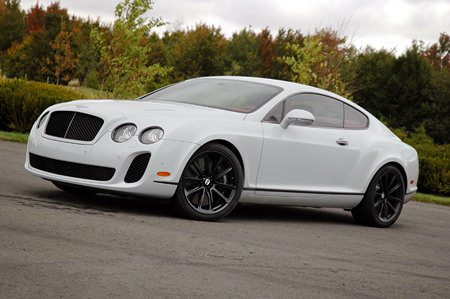In 1993, energy technologist Amory Lovins of the Rocky Mountain Institute suggested that major automakers could use existing materials and technologies to produce an ultra-lightweight, highly fuel-efficient vehicle. The ‘supercar’ he envisioned would incorporate lightweight plastics, computerized controls, and a hybrid powerplant. It would weigh roughly 500 kg and achieve well over 150 miles per gallon. Lovins felt it would, however, need a revolution in the industry to change the engineering concepts of ‘power’, rather than ‘weight’.
But as lightweight materials have become cheaper to manufacture and use, their adoption in production cars has become more widespread. Magnesium and aluminium alloys created car parts that were cost-competitive with conventional components. An example is that BMW uses a magnesium block and they took 10 kg off the weight of the engine alone, obviously a major gain and also lowered the car’s centre of gravity by 25 mm so it improved handling.
 Bentley SuperSports.
Bentley SuperSports.
BMW are not alone in the weight loss department. Bentley have produced the new Supersports, which boasts a zero to 100 km/h time of 3.9 seconds, despite its weight of 2240 kg. However, this all-up weight is over 110 kg lighter than the base model Bentley (if there ever is such a thing as a “base model” Bentley)!
It was the late Colin Chapman who really applied the light weight concept to F1 cars many decades ago, and the Bentley exercise shed weight by firstly tossing out the rear seats (26 kg saved), then another 45 kg was saved by replacing the sumptuous leather front seats with new carbon fiber bucket seats (sourced from the Bugatti Veyron). Carbon fiber disc brakes saved another 39 kg.
The Supersports features the same twin turbo 6.0 liter W12 (ex-VW) engine to other Continental models, but the boost pressure has been increased to produce 463 kW at 6000 rpm and 800 Nm of torque at 1700-5600 rpm. Look back at the BMW concept which has 265 kW and 800 Nm of torque in total and, since it weighs only 1395 kg, as opposed to the 2240 kg of the Bentley, which one will you put your money on for a standing start 400 meters? Well, I hope you did put your money on the Bentley which covers zero to 100 kph in 3.9 seconds, but the BMW is no slouch either having a 0-100 kph times of 4.8 seconds, despite giving away 200 kW to the Bentley.
Amory Lovins’ concept was made public over 20 years ago, but the technology direction he proposed has now been shown to be on the right track (and that’s not racing track, but the everyday highways). Hybrids are definitely here, and Toyota and Honda are expanding this technology throughout the range of their vehicles (take a look at the tail end of the next Camry you see – it just might say “Hybrid”).
Fuel economy is becoming increasingly important in a world that is afraid of crude oil shortages and increasing prices as the world’s economic crisis hopefully passes. For example, BMW’s Vision ED will return 3.8 litres per 100 km. The production BlueZero vehicles from Mercedes-Benz are also under 5 litres per 100 km, as are VW’s Blue Motion range.
The winds of change are upon us. Stylists are less important. Engineers are more important, and technology will reign supreme.




